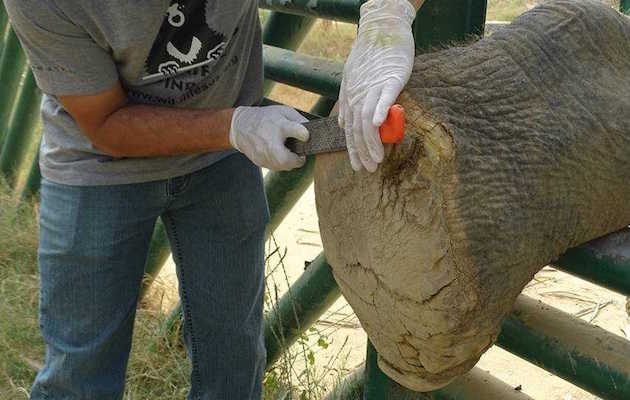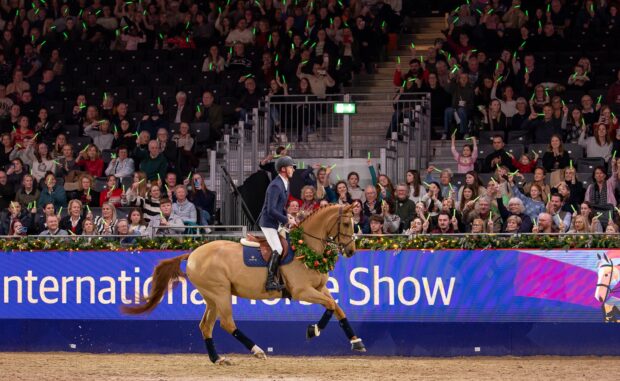A hoof treatment borrowed from the equine world is being used to help rehabilitate rescued captive elephants in India.
Sole Guard is a liquid hoof protector that is painted on to the foot where it dries and forms a cushioning layer. It is most commonly used on barefoot horses to give them additional comfort when riding on hard ground.
But when Indian wildlife conservation organisation Wildlife SOS wanted something to help the sore feet of elderly elephant Gajraj, they consulted experts who suggested they try the product.
Gajraj had spent 70 years as a temple elephant before becoming one of 24 the organisation has rescued.
“Years of walking on hot, unnatural surfaces led to the gradual degradation of Gajraj’s footpads, wearing them so thin that in some places his sole has become a painful pink color,” said Wildlife SOS co-founder Kartick Satyanarayan.
“Concerned about Gajraj’s footpads, particularly the pink portion of his left hind foot, the veterinarians at the Elephant Conservation and Care Center consulted with international experts who helped them come up with an innovative solution to the problem.”
Sole Guard, which is manufactured by US company Vettec, usually lasts for around three weeks on a horse, Gajraj’s size means he requires more regular treatments.
“The weight and usage of an elephant is obviously very different, and after about a week of walking around, the natural exfoliation of the foot causes the layer to loosen from an elephant’s sole, and requires replacement,” Kartick added.
“So far, Sole-Guard has proven quite beneficial in protecting the delicate portion of Gajraj’s feet, and we plan to continue using it to allow the footpad to heal underneath without the risk of punctures or infections.

“Depending on the positive results, we will move on to adapt the same process for other rescued elephants in our care.”
Fortunately, Gajraj has been a willing patient, placing his foot on a bar so vets can treat him.
“He has been receptive to positive conditioning and training during medical procedures, and as such is a very willing participant in his treatment — so long as he receives a steady stream of treats, anyway,” Kartick explained.
“The vets brush off any mud or dirt on the bottom of his foot, ensure it is clean and dry before squeezing a little less than half the tube of Sole-Guard onto the pinkish, compromised portion of his footpad.
“A plastic sheet is then placed over the gel to spread it out and hold it in place, and in less than a minute the liquid solidifies into a dark coating under Gajraj’s foot. He can then comfortably place the foot down and walk about with no trouble at all.”
Wildlife SOS was established in 1995 by Kartick Satyanarayan and Geeta Seshamani with the aim of providing sustainable alternative livelihoods and education to communities dependent on wildlife and natural resources.
Their first major project was to abolish the practice of poaching wild sloth bear cubs, who were trained to “dance” for tourists.
Continues below…

Move over ponies, here comes elephant polo
18 giant steeds will take part in the King’s Cup Elephant Polo Tournament

Baby elephants receive specially tailored horse rugs for winter
Baby elephants in Zambia will be keeping warm this winter, thanks to specially tailored horse rugs this winter

Can elephants be trained like horses?
There aren’t many obvious similarities between equines and elephants — but a world-renowned trainer thinks they’ve got more in common
Since 2009, Wildlife SOS also began to rescue and rehabilitate elephants, many of whom suffer from the same foot problems as Gajraj.
“Forced to walk on hot tar roads for hours at a stretch and made to carry heavy load on their backs, has taken a severe toll on their feet. Their foot pads are worn off and they suffer from overgrown cuticles and foot pads,” Kartick added.
“Almost all of our rescued and rehabilitated Asian elephants have been subjected to decades of abuse and torture which has left them with severe physical and emotional scars.”
For all the latest news analysis, competition reports, interviews, features and much more, don’t miss Horse & Hound magazine, on sale every Thursday.




